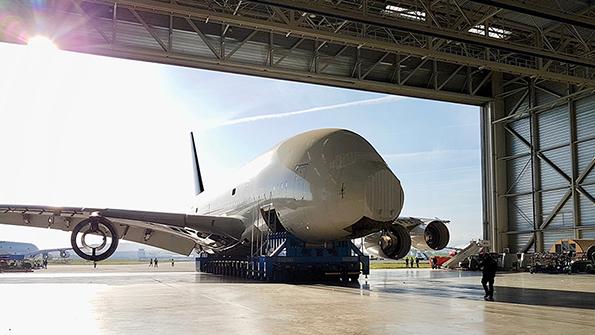
Early in 2019, Airbus’ salespeople had to accept the harsh reality that the market for new A380s was too slow for production to be sustained beyond 2021. They now seem to have concluded that the secondhand market also is weaker than they thought. And so the program is moving to a phase where the keywords will be “dispatch reliability” and “spare parts,” rather than “new operator.”
Asked whether Airbus has a target number for placing pre-owned A380s, Chief Commercial Officer Christian Scherer answered in the negative. “We do not see a major role for us in remarketing,” he told members of AJPAE, the French aerospace journalists association.
- Facing critics on reliability, Airbus prioritizes “continuity of operations”
- Lessor, dismantling company see demand for used spare parts
In March, Sunny Guglani, then head of A380 product marketing, had some ambitions for the secondhand market. “We are convinced it will be an opportunity for more carriers to afford A380s, and we are going to support and promote this market,” he told French daily Les Echos at the time. Lufthansa had just announced it would return six of its 14 A380s to Airbus in 2022 and 2023. The new priority is supporting current operators. Airbus is focusing on continuity of operations, says Scherer. At the least, Airbus executives may want to shore up the aircraft’s reputation.
Air France has begun retiring its A380 fleet, and Air France-KLM group CEO Ben Smith was one of the company officials who publicly criticized the aircraft’s performance. “This is the poorest operating aircraft in the fleet. We have enormous amounts of delays on this aircraft and this fleet has the highest rate of cancellations,” he said in November. “Getting these aircraft out sooner rather than later is going to help the operations at Air France.” Though that fleet is only 10 aircraft strong, said Smith, they “drive a lot of decisions.”
Scherer emphasizes ongoing investments some are making in their A380s: Lufthansa and Qantas have planned significant cabin upgrades, simultaneous with D checks, he says. Airbus is keeping a close eye on the schedule for the first such 90-day-long overhaul. They will begin soon, as they are done every 12 years. The airframer wants the A380 D checks—a major event in an aircraft’s life—to be as smooth as possible.
Perhaps the most worrying evidence about the viability of the A380’s secondhand market has been the difficulty Dr. Peters, a Germany-based lessor, has had in placing ex-Singapore Airlines aircraft. Since November 2017, the carrier has returned four. “We have talked to numerous airlines about both a follow-on lease and a sale. . . . The best economic solution turned out to be the part-out route,” says Christian Mailly, Dr. Peters’ head of aviation. That option was used for two of the four aircraft.
For the other two A380s, currently in storage, “we continue to seek a viable solution for our investors, which includes leasing out the engines in the interim,” he adds.
Another lessor, Doric, in 2018 placed an ex-Singapore Airlines A380 with Hi Fly, a wet-lease specialist based in Portugal.
The outlook for the A380 leasing market is gloomy, according to Mailly. “The A380 market has been challenging for some time and has been aggravated by Airbus announcing the production stop earlier this year; further A380s will be withdrawn from flight operations in the coming years and this will not make it any easier,” he says. Scope Analysis, a Germany-based consultancy, says investors cannot expect the high single-digit percentage returns originally projected and will have to make do with lower single digits.
The crystal ball is not as dark in everyone’s view. Sebastien Maire, associate director at consultancy Kea & Partners, is relatively optimistic about the market for secondhand A380s. As returned aircraft have now paid for themselves, their cost of ownership has decreased. Combined with the emerging availability of cheaper spare parts, this will make the A380’s economic performance competitive with that of newer aircraft, he says.
The dismantling of two of Dr. Peters’ A380s is supplying the cheaper components. In Tarbes, in the southwest of France, Tarmac Aerosave has started the final phase of disassembly. In November, it cut down the fuselage of the first one and sorted metals. The second one will follow in January.
This imposing task—Tarmac uses a diamond wire-cutting gantry and sorts nuances of aluminum—came after the removal of those parts that could be sold on the aftermarket. Demand for spare parts was so strong that the number of components Tarmac removed stood close to 6,000 per A380, up from 700-1,000 for an A330.
“We even removed engine pylons for reuse, which is generally not the case,” says Gregory Beyneix, Tarmac’s vice president for programs and operations. Parts as large as the rudder and flaps were removed, too. The savings from secondhand parts can be considerable, as a new A380 main landing gear is priced at around $25 million, according to Scope Analysis.
As of Nov. 30, Airbus had delivered 240 A380s to 15 operators. The backlog still contains 10, mainly earmarked for Emirates. One will be handed over to All Nippon Airways.
—With Helen Massy-Beresford in Paris


